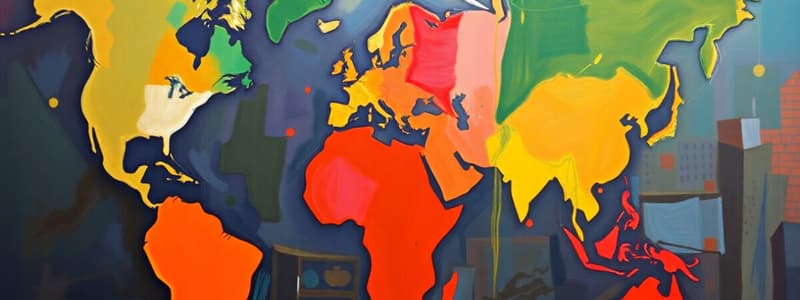Podcast
Questions and Answers
Which of the following best describes globalization according to Kenichi Ohmae's theory of a borderless world?
Which of the following best describes globalization according to Kenichi Ohmae's theory of a borderless world?
- It is solely focused on economic growth.
- It creates a world that can operate without close network connections. (correct)
- It is an institution with a defined structure.
- It is a process limited to cultural exchanges.
What does the theory of time-space compression imply about modern globalization?
What does the theory of time-space compression imply about modern globalization?
- Distance has become irrelevant due to advancements in communication technology. (correct)
- Cultures are becoming more isolated from each other.
- Time has no effect on the movement of goods and people.
- Globalization solely benefits developed nations.
Which aspect does Anthony Giddens' theory of time-space distanciation highlight?
Which aspect does Anthony Giddens' theory of time-space distanciation highlight?
- Local events have no connection to global occurrences.
- Events occurring in one location can significantly shape social relations in faraway places. (correct)
- Technology distances us from our local communities.
- Social relations are becoming irrelevant in the modern age.
Robertson's concept of global consciousness refers to which of the following?
Robertson's concept of global consciousness refers to which of the following?
What does the transformationalist view on globalization suggest?
What does the transformationalist view on globalization suggest?
What are the three primary dimensions of globalization mentioned in the content?
What are the three primary dimensions of globalization mentioned in the content?
Which of the following describes the belief held by Thomas Friedman regarding globalization?
Which of the following describes the belief held by Thomas Friedman regarding globalization?
What portrayal of globalization is offered by Urry's 'Sociology Beyond Societies'?
What portrayal of globalization is offered by Urry's 'Sociology Beyond Societies'?
Study Notes
What is Globalization?
- Globalization is a multifaceted concept, not synonymous with internationalization or liberalization.
- It is a process, an institution, an outcome, and a practice, influencing socio-economic development.
- Globalization can be economic, political, or cultural.
Globalization Theory
- The Borderless World theory (Kenichi Ohmae, 1994) posits that globalization brings improvement in human conditions, creating an "invisible continent" able to operate effectively globally without strong ties to specific regions.
- The Communication Revolution theory (Thomas Friedman, 2000) emphasizes the role of falling telecommunications costs due to technologies like microchips, satellites, fiber optics, and the internet in driving globalization.
- The Time-Space Distanciation theory (Anthony Giddens, 1990) highlights how locales are shaped by distant events and vice versa, creating disembedded social relations.
- The Time-Space Compression theory (David Harvey, 1994) focuses on the shrinking of the world into a "global village" through technological advancements that reduce time and increase efficiency.
- The Sociology Beyond Societies theory (Urry, 2000) shifts the focus from society to space, networks, and fluid movement of people, images, goods, finances, etc. across regions.
- The Global Consciousness and Global Compression theory (Robertson, 1992) links globalization to a heightened awareness of the world as a whole, driven by increased interdependence.
- The Transformationalist View (Held and McGrew, 2000) sees globalization as a force creating profound change, forcing states and societies to adapt to a more interconnected and uncertain world.
- This view emphasizes the stretching of social, political, and economic activities across borders.
Studying That Suits You
Use AI to generate personalized quizzes and flashcards to suit your learning preferences.
Related Documents
Description
Explore the multifaceted concept of globalization through various theoretical lenses. This quiz tackles the differences between globalization, internationalization, and liberalization while assessing theories such as Borderless World, Communication Revolution, and Time-Space Distanciation. Test your knowledge on how these theories influence socio-economic development.




